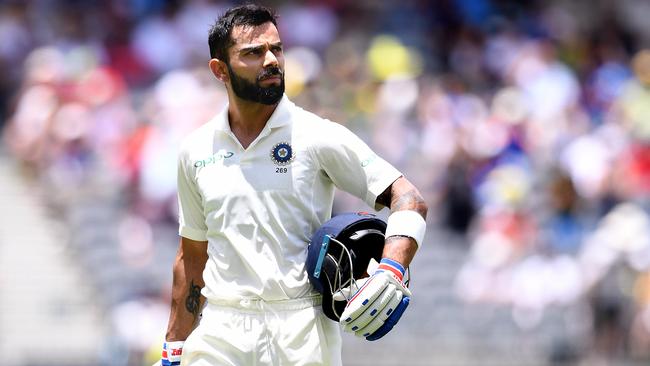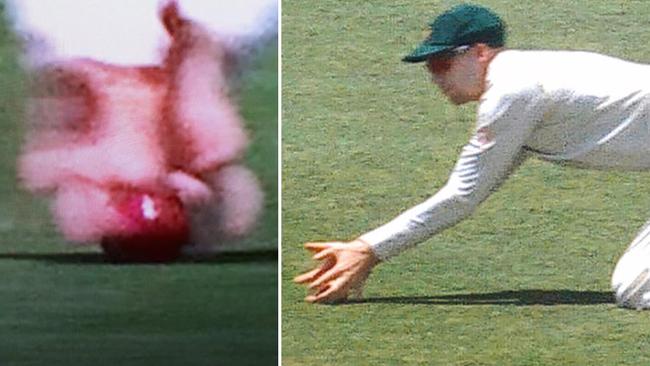Perth Test: Softly does it as Australia get down to graft
Did you want to see Virat Kohli bat on? Did you think Pat Cummins deserved a wicket? Maybe, like me, you wished for both.

It was an updating, almost a remake, of an old, old story.
These days the cricket umpire on international duty can appear a marginal figure, a mid-level bureaucrat exercising a limited discretion preliminary to the definitive business of technological retrospection and media analysis. Sometimes, the players even seem to be umpiring themselves, unofficial field workers of the Decision Review System.
All the more so yesterday as Virat Kohli outside edged and Peter Handscomb rolled to his right at second slip, and tempered celebrations broke out.
Kohli walked down the pitch with a nonchalant waft of his left hand, indicating belief that the ball had bounced; Handscomb raised his index finger, confirming conviction it had not. No consensus emerging, umpire Kumar Dharmasena conclaved with Chris Gaffaney preparatory to calling on their video reinforcement Nigel Llong. Then, almost furtively, Dharmasena gave his so-called “soft signal” — the “I think” gesture distinguishable from the “I know” by its seeming circumspection, but in this instance carrying immense weight.
Every time Kohli leaves the crease in this Border-Gavaskar Trophy will involve a shift in the balance of power — heaven knows, it could affect Australia-India diplomatic relations and the terms of trade. The circumstances of his departure will matter accordingly.
The next few minutes turned into a Rorschach inkblot test. As it was replayed at multiple speeds from multiple angles, objectivity was elusive. Were you an Indian fan, or an Australian diehard? Did you want to see Kohli bat some more? Did you think Pat Cummins deserved a wicket? Maybe, like me, to add to the confusion, you wished for both.

Additional context came from Handscomb being the player who drew Steve Smith’s attention to the Australian team balcony in Bangalore last year because, he said, he did not understand the review system, the “protocols” of the elders of Dubai. In the home dressing room, too, those well-publicised signboards enjoining occupants to practise “elite honesty” which invited so much ironic commentary.
For the older generation it was also an opportunity to explain to the younger that this was the way it used to be, in that olden time when Jack Fingleton said that umpires were more powerful than presidents and prime ministers, able to provoke a nation to jubilation or fury with a single finger.
Back in the day, the decisions were hard, fast, sometimes wrong, essentially respected. And for all this decision’s “softness”, it possessed an authoritative quality, low catches almost invariably going the way of the soft signal because contradiction of the on-field umpire requires definitive evidence — the “soft signal” has become, in its way, the most adamantine of all.
So it went. Kohli wended his way off in a dudgeon of medium height, precluding acknowledgment of applause for his superfine hundred. The Australians were rightly confident to have turned the game.
We were left a cricketing tabula scalata or rabbit-duck illusion — although the latter could equally refer to Mohammed Shami, a number 8 with an average of 11 now dismissed by his last three deliveries in Test cricket, and almost lucky to have survived that long.
To that stage, Kohli had appeared impassable, driving through the covers without check, copping one on the tattoo without flinching, reaching his 25th Test hundred with a punch down the ground and a gesture that could start an Indian fad for batting glove puppets.
With his dismissal, India, as many had foreseen, dropped their tail like a skink, losing five for 32 in 77 deliveries, four of these to Nathan Lyon.
At its effective midpoint, in fact, seven of the match’s 20 wickets had fallen to spin: a nod to this new, intriguing, changeable pitch that has so defied prediction, arriving like a green mamba and as amiable at other times as Kermit the Frog.
What next? Perhaps the first hint of the ball coming through at differing heights and of the influence of a widening crack just short of a good length at the Langer Stand end, plus of the ongoing cost of the composition of India’s XI.
Ishant Sharma, Jasprit Bumrah and Shami took four wickets, Aaron Finch’s finger, Marcus Harris’s badge, Usman Khawaja’s top hand, Tim Paine’s bottom hand. But Umesh Yadav went on appearing surplus, surrendering nearly a run a ball in a match in which runs have been at a premium.
Meantime, social media debate roiled, about not only Kohli but also that mother of all cricketgates, Monkeygate, being rehashed by its chief antagonists Andrew Symonds and Harbhajhan Singh and their online proxies.
For those recollecting that Sydney Test, it seemed both just yesterday and long ago: another game marred by umpiring decisions but also a relic of the pre-DRS world. Much has been done since to narrow and neutralise the potential for similar conflicts. But still, we were reminded yesterday, they cannot be eliminated altogether.


